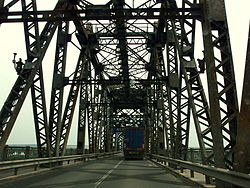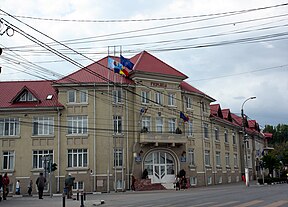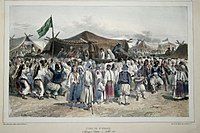Giurgiu
You can help expand this article with text translated from the corresponding article in Romanian. (February 2013) Click [show] for important translation instructions.
|
This article needs additional citations for verification. (August 2013) |
Giurgiu | |
|---|---|
| Coordinates: 43°54′03″N 25°58′26″E / 43.90083°N 25.97389°E | |
| Country | Romania |
| County | Giurgiu |
| Government | |
| • Mayor (2020–2024) | Adrian Anghelescu[1] (PNL) |
Area | 46.94 km2 (18.12 sq mi) |
| Elevation | 25 m (82 ft) |
| Population (2021-12-01)[2] | 54,551 |
| • Density | 1,200/km2 (3,000/sq mi) |
| Time zone | EET/EEST (UTC+2/+3) |
| Postal code | 080011–080882 |
| Area code | (+40) 02 46 |
| Vehicle reg. | GR |
| Website | www |



Giurgiu (Romanian pronunciation: [ˈdʒjurdʒju] ⓘ; Template:Lang-bg) is a city in southern Romania. The seat of Giurgiu County, it lies in the historical region of Muntenia. It is situated amongst mud-flats and marshes on the left bank of the Danube facing the Bulgarian city of Ruse on the opposite bank. Three small islands face the city, and a larger one shelters its port, Smarda. The rich grain-growing land to the north is traversed by a railway to Bucharest, the first line opened in Romania, which was built in 1869 and afterwards extended to Smarda. In the past, Giurgiu exported timber, grain, salt and petroleum, and imported coal, iron, and textiles.[3]
The Giurgiu-Ruse Friendship Bridge, in the shared Bulgarian-Romanian section of the Danube, crosses the river in the outskirts of the city.
History
The area around Giurgiu was densely populated at the time of the Dacians (1st century BC) as archeological evidence shows, and Burebista's capital was in this area (it is thought to be in Popești on the Argeș River). During Roman times this was the site of Theodorapolis, a city built by the Roman emperor Justinian (483–565).
The city of Giurgiu was probably established in the 14th century as a port on the Danube by the Genoese merchant adventurers, who established a bank and traded in silks and velvets.[3]
One theory is that they called the city after the patron saint of Genoa, San Giorgio (Saint George), however Nicolae Iorga disputes this theory, arguing that Giurgiu is just an old Romanian form of George.[4]
It was first mentioned in Codex Latinus Parisinus in 1395, during the reign of Mircea the Elder, and was conquered by the Ottomans in 1420 as a way to control the Danube traffic. The Ottomans named the city Yergöğü, as if from yer 'earth' + gök 'sky,' but the name was probably given because of the similarity between the pronunciations of "(San) Giorgio" and "Yergöğü".
As a fortified city, Giurgiu figured often in the wars for the conquest of the lower Danube. It was the site of the October 1595 Battle of Giurgiu, and figured in the struggle of Michael the Brave (1593–1601) against the Turks and in the later Russo-Turkish War (1787–1792). It was burned in 1659. In 1771, the Ottomans built the historic Giurgiu Clocktower as a surveillance tower for Danube traffic. In 1829, its fortifications were finally razed, the only defence left being a castle on the island of Slobozia, connected to the shore by a bridge.[3]
In 1952–1954, during the Communist regime, the Soviet Union helped build the bridge between Giurgiu and Ruse, The Friendship Bridge, a bridge on the Danube linking Romania and Bulgaria.
Jewish history
Sephardi Jewish merchants came to Giurgiu from the Balkans in the 1820s and Ashkenazi Jews settled later, leading to communal disputes. A 70-member Zionist group was formed in 1899. A joint Jewish school opened in 1878, with 60 pupils in 1910. The Jewish population by that point was 533, or 4% of the total.[5] By 1930, their number had fallen to 207, or 0.7%.[6] Jews were forced to forfeit their property to the Iron Guard in 1941 and at least half of the 113 Jews living there that year left. A community existed after World War II.[5]
Demographics
| Year | Pop. | ±% |
|---|---|---|
| 1859 | 10,557 | — |
| 1900 | 13,977 | +32.4% |
| 1912 | 20,629 | +47.6% |
| 1930 | 31,016 | +50.4% |
| 1941 | 26,551 | −14.4% |
| 1948 | 30,197 | +13.7% |
| 1956 | 32,613 | +8.0% |
| 1966 | 39,199 | +20.2% |
| 1977 | 51,544 | +31.5% |
| 1992 | 74,191 | +43.9% |
| 2002 | 69,587 | −6.2% |
| 2011 | 54,655 | −21.5% |
| 2021 | 54,551 | −0.2% |
| Source: Census data, 1930–1948.[7] | ||
According to the 2021 census, Giurgiu has a population of 54,551.
Notable natives
- Constantin Artachino (1870–1954), painter
- Ioan A. Bassarabescu (1870–1952), writer
- Nicolae Dărăscu (1883–1959), painter
- Toma Ghițulescu (1902–1983), engineer, politician, and Olympic bobsledder
- Emil Gulian (1907–1942), poet
- Gino Iorgulescu (b. 1956), former Romanian football international
- Dumitru Iuca (1882–1940), politician
- Theodor Anton Neagu (b. 1932), palaeontologist
- Miron Nicolescu (1903–1975), mathematician, President of the Romanian Academy
- Eugenia Popescu-Județ (1925–2011), dancer
- Paraskev Stoyanov (1876–1940), Bulgarian physicist and surgeon
- Constantin Teașcă (1922–1996), football coach and writer
- Alexandru Vianu (1903–1936), writer and translator
- Tudor Vianu (1898–1964), literary critic, art critic, poet, philosopher, academic, and translator
- Ion Vinea (1895–1964), poet, novel, journalist, literary theorist, and political figure
- Vasil Zlatarov (1869–1932), Bulgarian aviation pioneer
International relations
Twin towns – Sister cities
Giurgiu is twinned with:
See also
- FC Astra Giurgiu, the city's professional football club
References
- ^ "Results of the 2020 local elections". Central Electoral Bureau. Retrieved 8 June 2021.
- ^ "Populaţia rezidentă după grupa de vârstă, pe județe și municipii, orașe, comune, la 1 decembrie 2021" (XLS). National Institute of Statistics.
- ^ a b c One or more of the preceding sentences incorporates text from a publication now in the public domain: Chisholm, Hugh, ed. (1911). "Giurgevo". Encyclopædia Britannica. Vol. 12 (11th ed.). Cambridge University Press. p. 54.
- ^ Iorga, Nicolae (1928). Istoria Românilor prin călători [History of Romanians through travellers] (in Romanian). Bucharest: Casa Școalelor. p. 18.
- ^ a b Shmuel Spector, Geoffrey Wigoder (eds.), The Encyclopedia of Jewish Life Before and During the Holocaust: A—J, p. 432. New York University Press, 2001, ISBN 0-8147-9376-2
- ^ Recensământul populației din 1930. Institutul Central de Statistică. p. 512.
{{cite book}}:|work=ignored (help) - ^ Populatia RPR la 25 ianuarie 1948, p. 14
- ^ "МЕЖДУНАРОДНО СЪТРУДНИЧЕСТВО НА ОБЩИНА РУСЕ - Побратимени градове". Община Русе [Municipality Ruse] (in Bulgarian). Archived from the original on 5 August 2013. Retrieved 12 August 2013.
External links
![]() Media related to Giurgiu at Wikimedia Commons
Media related to Giurgiu at Wikimedia Commons









